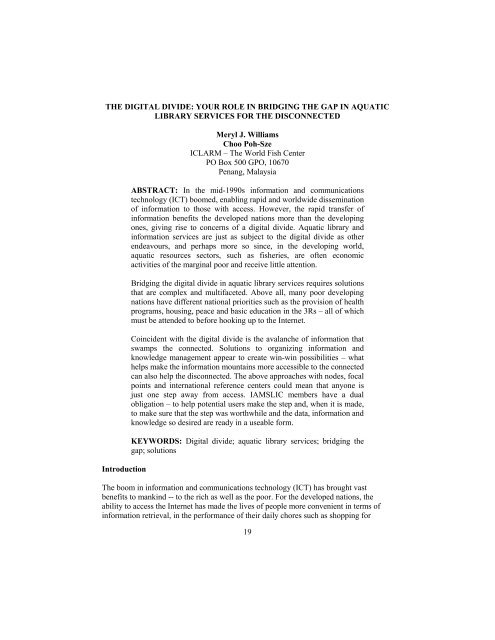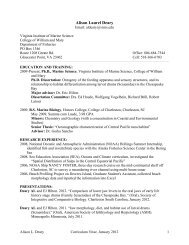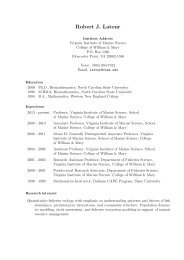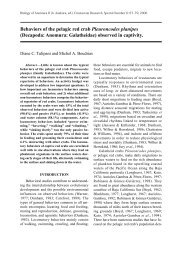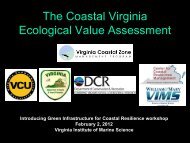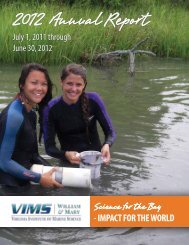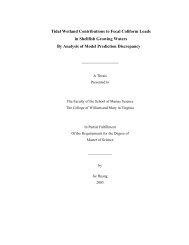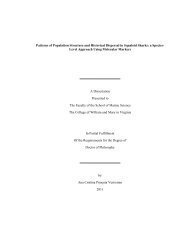The Digital Divide: bridging the gap for the ... - ResearchGate
The Digital Divide: bridging the gap for the ... - ResearchGate
The Digital Divide: bridging the gap for the ... - ResearchGate
- No tags were found...
Create successful ePaper yourself
Turn your PDF publications into a flip-book with our unique Google optimized e-Paper software.
THE DIGITAL DIVIDE: YOUR ROLE IN BRIDGING THE GAP IN AQUATICLIBRARY SERVICES FOR THE DISCONNECTEDIntroductionMeryl J. WilliamsChoo Poh-SzeICLARM – <strong>The</strong> World Fish CenterPO Box 500 GPO, 10670Penang, MalaysiaABSTRACT: In <strong>the</strong> mid-1990s in<strong>for</strong>mation and communicationstechnology (ICT) boomed, enabling rapid and worldwide disseminationof in<strong>for</strong>mation to those with access. However, <strong>the</strong> rapid transfer ofin<strong>for</strong>mation benefits <strong>the</strong> developed nations more than <strong>the</strong> developingones, giving rise to concerns of a digital divide. Aquatic library andin<strong>for</strong>mation services are just as subject to <strong>the</strong> digital divide as o<strong>the</strong>rendeavours, and perhaps more so since, in <strong>the</strong> developing world,aquatic resources sectors, such as fisheries, are often economicactivities of <strong>the</strong> marginal poor and receive little attention.Bridging <strong>the</strong> digital divide in aquatic library services requires solutionsthat are complex and multifaceted. Above all, many poor developingnations have different national priorities such as <strong>the</strong> provision of healthprograms, housing, peace and basic education in <strong>the</strong> 3Rs – all of whichmust be attended to be<strong>for</strong>e hooking up to <strong>the</strong> Internet.Coincident with <strong>the</strong> digital divide is <strong>the</strong> avalanche of in<strong>for</strong>mation thatswamps <strong>the</strong> connected. Solutions to organizing in<strong>for</strong>mation andknowledge management appear to create win-win possibilities – wha<strong>the</strong>lps make <strong>the</strong> in<strong>for</strong>mation mountains more accessible to <strong>the</strong> connectedcan also help <strong>the</strong> disconnected. <strong>The</strong> above approaches with nodes, focalpoints and international reference centers could mean that anyone isjust one step away from access. IAMSLIC members have a dualobligation – to help potential users make <strong>the</strong> step and, when it is made,to make sure that <strong>the</strong> step was worthwhile and <strong>the</strong> data, in<strong>for</strong>mation andknowledge so desired are ready in a useable <strong>for</strong>m.KEYWORDS: <strong>Digital</strong> divide; aquatic library services; <strong>bridging</strong> <strong>the</strong><strong>gap</strong>; solutions<strong>The</strong> boom in in<strong>for</strong>mation and communications technology (ICT) has brought vastbenefits to mankind -- to <strong>the</strong> rich as well as <strong>the</strong> poor. For <strong>the</strong> developed nations, <strong>the</strong>ability to access <strong>the</strong> Internet has made <strong>the</strong> lives of people more convenient in terms ofin<strong>for</strong>mation retrieval, in <strong>the</strong> per<strong>for</strong>mance of <strong>the</strong>ir daily chores such as shopping <strong>for</strong>19
necessities, payment of bills as well as banking and o<strong>the</strong>r business transaction, and inrecreation and access to culture. ICT benefits <strong>the</strong> poor by removing social, economic andgeographical isolation, by increasing access to in<strong>for</strong>mation and education, and byenabling poor people to participate in more of <strong>the</strong> decisions that affect <strong>the</strong>ir lives (<strong>The</strong>Human Development Report 2001). <strong>The</strong> Report provided examples and showed how ICTgave poor people political empowerment in <strong>the</strong> Philippines and Honduras. In Honduras, itenabled a fishermen’s organization to send a video on illegal mangrove felling toCongress. ICT has created jobs in Costa Rica, India and South Africa, and providedhealth networks in Gambia and Nepal.Some development agencies, however, fear that <strong>the</strong> ICT fad may detract donors, and maydrain resources and support <strong>for</strong> traditional development goals. O<strong>the</strong>rs fear that <strong>the</strong> moredeveloped nations, which can utilize <strong>the</strong> technology more effectively than <strong>the</strong> developingnations, may lead to fur<strong>the</strong>r marginalization of <strong>the</strong> poor.Over <strong>the</strong> last couple of years, <strong>the</strong>re is active discussion on <strong>the</strong> digital divide where <strong>the</strong>development of ICT is believed to have widened fur<strong>the</strong>r <strong>the</strong> opportunity <strong>gap</strong> between <strong>the</strong>haves and <strong>the</strong> have-nots. <strong>The</strong>re is a real risk that <strong>the</strong> interests of poor people and poorcountries are being left on <strong>the</strong> sidelines, and governance of <strong>the</strong> Internet needs to bewidened to bring in <strong>the</strong> needs and concerns of developing countries (UNDP 1999).<strong>The</strong> digital divide is not a new problem- whenever new technologies were introduced,disparity arose between those who could af<strong>for</strong>d <strong>the</strong> technology and those who could not,and technology transfer programmes, too, have existed <strong>for</strong> many decades (Bridges.orgreport: http://www.bridges.org/spanning/chpt4.html- downloaded on 6 July 2002). James(1999- quoted from Bridges.org) noted <strong>the</strong> similarities between <strong>the</strong> current ICT age and<strong>the</strong> Green Revolution, and urged that we learn from past mistakes and draw on successesin our quest to bridge <strong>the</strong> digital divide.Bridging <strong>the</strong> digital divide requires a clear understanding of <strong>the</strong> issues and <strong>the</strong> objectives,be<strong>for</strong>e solutions can be considered. In <strong>the</strong> library in<strong>for</strong>mation services, even be<strong>for</strong>e <strong>the</strong>digital age, disparity existed between <strong>the</strong> rich and <strong>the</strong> poor nations in <strong>the</strong>ir ability toprocure books, journals and o<strong>the</strong>r documents. <strong>The</strong> ICT era has merely aggravated thissituation.<strong>The</strong> digital age is definitely here to stay. A study carried out at <strong>the</strong> School <strong>for</strong> In<strong>for</strong>mationSystems in <strong>the</strong> University of Cali<strong>for</strong>nia showed that growth of digital in<strong>for</strong>mation is <strong>the</strong>fastest compared to all o<strong>the</strong>r <strong>for</strong>ms; most of <strong>the</strong> in<strong>for</strong>mation is created by individuals,amounting to a total of 740,000 terabytes (thousand billion bytes) a year versus a mere285 terabytes from published in<strong>for</strong>mation (Anon 2000). ICT innovations, which are moreeffectively used by <strong>the</strong> richer nations, are continuously rolled out due to <strong>the</strong> rapidadvancement of <strong>the</strong> digital frontier.<strong>The</strong> divide is of varying “widths” across <strong>the</strong> developing world but nowhere does it seemto be narrowing, even though many developing nations have given prominence to ICT20
development. To find solutions to <strong>bridging</strong> <strong>the</strong> <strong>gap</strong> would <strong>the</strong>re<strong>for</strong>e require specificationof <strong>the</strong> level of technology one hopes to bridge. Statistics on <strong>the</strong> availability of digitalinfrastructures, availability of computer hardware and software, availability of ICTspecialists and in<strong>for</strong>mation on users of digital technology <strong>for</strong> in<strong>for</strong>mation retrieval, wouldprovide a better perspective on <strong>the</strong> “width” of <strong>the</strong> <strong>gap</strong>, and would help provide solutionson how to bridge, or at least narrow this divide.In library in<strong>for</strong>mation services, <strong>the</strong> most important need would be to ensure that those in<strong>the</strong> developing nations are able to gain access to in<strong>for</strong>mation quickly, even though <strong>the</strong>ymay lag behind in <strong>the</strong> latest ICT development. <strong>The</strong> mountains of digital in<strong>for</strong>mation needto be organized and managed <strong>for</strong> ease of retrieval subsequent to knowledge conversion. Itis critical that professionals in <strong>the</strong> library in<strong>for</strong>mation services reexamine <strong>the</strong>ir roles toensure that <strong>the</strong> services <strong>the</strong>y provide are able to meet <strong>the</strong> challenges posed by <strong>the</strong> digitalage, and to ensure that <strong>the</strong>y still play a relevant and effective role in in<strong>for</strong>mationdissemination and knowledge enhancement.Development of ICT<strong>The</strong> invention of <strong>the</strong> electronic computer in 1939 marked <strong>the</strong> beginning of <strong>the</strong> electronicage. This invention was surrounded with controversy, with two parties (John Atanasoff,and Mauchly and Eckert) laying claims to <strong>the</strong> honour. This dispute was finally settleddecades later in <strong>the</strong> United States Supreme Court, which recognised Atanasoff as <strong>the</strong>inventor (http://www.<strong>the</strong>historychannel.com/timeline/main.html). <strong>The</strong> electroniccomputer did not yet herald <strong>the</strong> boom in in<strong>for</strong>mation technology; it took a few moredecades and several o<strong>the</strong>r milestone events (seehttp://www.<strong>the</strong>historychannel.com/timeline/main.html), such as <strong>the</strong> invention of <strong>the</strong>transistor (thus ushering in <strong>the</strong> age of modern electronics), <strong>the</strong> development of computermemory in 1948, <strong>the</strong> invention of <strong>the</strong> email in 1972, and <strong>the</strong> invention of World Wideweb in 1990 at <strong>the</strong> European Organisation <strong>for</strong> Nuclear Research (CERN) in Geneva, toinitiate <strong>the</strong> digital in<strong>for</strong>mation boom. <strong>The</strong> announcement by CERN that it would notcharge fees <strong>for</strong> <strong>the</strong> use of <strong>the</strong> web, helped to shape its future as an open and freecommunication area.Fur<strong>the</strong>r advances, which spur <strong>the</strong> world towards <strong>the</strong> age of in<strong>for</strong>mation technology,include <strong>the</strong> development in 1993 of Adobe Acrobat, software designed to distributeidentical copies of electronic documents. In 1993 Stephen King published a short storycollection “Nightmares and Dreamscapes” on <strong>the</strong> Internet. In 1994 search engines -Netscapes and Yahoo- were launched. In 1997 Microsoft purchased WebTV Networks,which has developed technology that enables users to read emails and surf <strong>the</strong> web on<strong>the</strong>ir television sets.<strong>The</strong> Internet has been described as <strong>the</strong> biggest library in <strong>the</strong> world with 24-hour access;<strong>the</strong> number of web pages doubles every 100 days, with <strong>the</strong> number of web-hostingcomputers doubling every seven months (Chowdhury 2000). A total of eight billion webpages is projected by 2004, but current search engines track only about 20 to 25% of <strong>the</strong>21
existing in<strong>for</strong>mation (Peizer 2000). Aquatic library and in<strong>for</strong>mation services are perhapssubjected more to <strong>the</strong> digital divide than o<strong>the</strong>r endeavours since, in <strong>the</strong> developing world,aquatic resources sectors, such as fisheries, with few exceptions, are often economicactivities of <strong>the</strong> marginal poor and receive little attention.<strong>Digital</strong> <strong>Divide</strong>: definition and causes<strong>The</strong> term digital divide often has different connotations to different people. Its definitiontakes on a range of comparisons from: better access to computers by <strong>the</strong> rich compared to<strong>the</strong> poor, and better computer knowledge among <strong>the</strong> young compared to <strong>the</strong> old, or <strong>the</strong>urban from <strong>the</strong> rural. It has also been noted that women face more restrictions than menin <strong>the</strong> use of ICT (Chamberlain 2002). <strong>The</strong>se differences may exist between or withincountries.<strong>The</strong> divide may also refer to <strong>the</strong> more effective use of ICT by developed countriescompared to those in <strong>the</strong> developing countries, and to a greater number of trained ICTspecialists in <strong>the</strong> developed countries compared to those from <strong>the</strong> developing countries.Since English is used in almost 80% of websites, <strong>the</strong>re may also be a divide betweenthose proficient in <strong>the</strong> English language and those who are not.<strong>The</strong> divide has been attributed to numerous reasons. It is inevitable that rich nations areoften <strong>the</strong> first to benefit when new technologies are introduced, due mainly to <strong>the</strong> factthat <strong>the</strong>y have better access to financial and trained human resources. Poorer nations,because of <strong>the</strong>ir commitment to o<strong>the</strong>r more urgent priorities such as <strong>the</strong> provision ofbetter health care, housing, peace and basic education in <strong>the</strong> 3Rs, may not be able toallocate resources <strong>for</strong> ICT development. Moreover, as reported in <strong>the</strong> HumanDevelopment Report 2001, technology tends to favour high-income consumers ra<strong>the</strong>rthan <strong>the</strong> needs of those with little purchasing power. Hence, development of low-costcomputers and low-literacy touch-screens <strong>for</strong> <strong>the</strong> poor lags behind ef<strong>for</strong>ts devoted to <strong>the</strong>development of faster and more sophisticated computers, which have a ready demandfrom <strong>the</strong> rich. One o<strong>the</strong>r development which promises to narrow <strong>the</strong> divide is <strong>the</strong> VoicePortal, which may enable people without computers or Internet access to obtainin<strong>for</strong>mation from <strong>the</strong> web, using just <strong>the</strong> telephone and <strong>the</strong>ir own voice, but it will bemany years be<strong>for</strong>e <strong>the</strong>y are widely used (Geer 2001).Internet accessInternet use has grown exponentially from 16 million users in 1995 to more than 400million in 2000, and is expected to reach 1 billion in 2005 (quoted from <strong>The</strong> HumanDevelopment Report 2001). Of <strong>the</strong> estimated 429 million people online globally, 41% arein North America, 27% in Europe, <strong>the</strong> Middle East and Africa, 20% in Asia Pacific and4% in South America (Nymia 2002).<strong>The</strong> ability to own computers is not merely an issue between countries; disparity existswithin countries as well. For example, in <strong>the</strong> United Sates of America, Whites are more22
likely to have access to <strong>the</strong> Internet from home than Blacks or Hispanics have from anylocation, and regardless of income level, Americans living in rural areas are laggingbehind in Internet access (NTIA 1999).One of <strong>the</strong> greatest constraints to Internet access in poor developing countries is <strong>the</strong> costof purchasing <strong>the</strong> hardware. In Bangladesh, <strong>for</strong> example, a computer costs more thaneight years of income of an average earner, compared to one month”s wage of an averageAmerican (UNDP 1999).General Solutions to <strong>Digital</strong> <strong>Divide</strong>Solutions to <strong>the</strong> digital divide require actions from various agencies and stakeholders, and<strong>the</strong> commitments of <strong>the</strong> governments as well as regional collaborative ef<strong>for</strong>ts andpartnerships. In <strong>the</strong> 56 General Assembly of <strong>the</strong> United Nations held in June 2002 (seewebsite: http://www.un.org/News/Press/docs/2002/GA 10031.doc.htm), participantsrecognized that <strong>the</strong> key causes are not simply technological but include also economicand social issues; <strong>bridging</strong> <strong>the</strong> divide would require concerns such as purpose, mindset,governance, leadership and vision. Participants also urged governments to recognize ICTas a necessity, not a luxury in government budgets, and equitable rules should beestablished to ensure that developing countries are not marginalized. <strong>The</strong> ICT era bringswith it a world economy that is increasingly dependent on digital-based in<strong>for</strong>mation;consequently <strong>the</strong> social well-being and economy of societies, communities and people aredependent on <strong>the</strong> successful mastery and utilization of ICT.More research should be directed towards technology, which is more user-friendly andaf<strong>for</strong>dable to <strong>the</strong> illiterate and <strong>the</strong> poor, and not just to cater to market demand.Swaminathan (2001) noted, “if <strong>the</strong> market is <strong>the</strong> sole determinant of research investmentdecisions, orphans will remain orphans and economic and technological divides willgrow”. Ventura (2001) observed that <strong>the</strong>re is as yet no well-publicized award of <strong>the</strong> statusof <strong>the</strong> Nobel Prize to recognize scientific work that directly improves <strong>the</strong> quality of life of<strong>the</strong> poor and underprivileged; such an award may spur interest in research towardspoverty alleviation. <strong>The</strong> availability of funding to carry out need-based and public goodresearch is critical to hasten <strong>the</strong> <strong>bridging</strong> of <strong>the</strong> digital divide. Funds should be allocatedto researchers, and recognition given to those who had contributed to research whichcontributes to human development (UNDP 1999).Libraries must also recognize that <strong>the</strong>y play a central role in providing solutions to <strong>the</strong>digital divide. <strong>The</strong>y may need to adapt <strong>the</strong>ir time-honored role as in<strong>for</strong>mation providersto <strong>the</strong> increasingly important <strong>for</strong>ms of digital in<strong>for</strong>mation, and <strong>the</strong>re is a need to devisestrategies <strong>for</strong> <strong>the</strong>ir effective and equitable dissemination.Roles of aquatic library services in in<strong>for</strong>mation acquisition and disseminationLibrary services play a central role in trans<strong>for</strong>ming in<strong>for</strong>mation into knowledge, and <strong>the</strong>latter into wisdom (Ventura 1997- quoted from Chowdhury 2000). Access to in<strong>for</strong>mation23
is essential to all sectors of society, and is a pre-requisite <strong>for</strong> research and development.Aquatic in<strong>for</strong>mation services, which provide specialized services tailored towards aquaticand fisheries sciences should understand fully <strong>the</strong> need of <strong>the</strong> users. Lourduswami (1996)noted that in<strong>for</strong>mation management “is all about getting <strong>the</strong> right in<strong>for</strong>mation, in <strong>the</strong> right<strong>for</strong>m, to <strong>the</strong> right person, at <strong>the</strong> right time, in <strong>the</strong> right place to arrive at <strong>the</strong> rightdecision” and all in<strong>for</strong>mation services should address <strong>the</strong> following issues:• Need: what <strong>the</strong> user ought to have• Want: what <strong>the</strong> user would like to have• Demand: what <strong>the</strong> user asks <strong>for</strong>• Use: what <strong>the</strong> user actually usesLourduswami (1996) recommended that when planning an aquatic resources library, <strong>the</strong>in<strong>for</strong>mation systems design phase has to be preceded by an in<strong>for</strong>mation audit to establishclearly <strong>the</strong> present and future requirements of those using <strong>the</strong> services.In <strong>the</strong> digital age, <strong>the</strong> traditional roles played by <strong>the</strong> library, as an institution to preserveand disseminate knowledge, have not changed essentially, but with <strong>the</strong> avalanche ofin<strong>for</strong>mation especially from <strong>the</strong> digital sector, it has become a challenge to manage allthis in<strong>for</strong>mation — to determine what is needed and useful <strong>for</strong> <strong>the</strong> users, and how tohandle and integrate <strong>the</strong> various <strong>for</strong>ms of in<strong>for</strong>mation (published, unpublished, printedand digital) poses big challengers to any library service. Lise Bissonnette, administrativehead of <strong>the</strong> Grande Bibliothéque du Québec, Montréal noted that “libraries have alwaystried to bring order to <strong>the</strong> chaos of knowledge, and with <strong>the</strong> explosion of in<strong>for</strong>mation, thischaos has never been greater” (Lawrence 2000).<strong>The</strong>re are, however, positive aspects associated with <strong>the</strong> age of computers and ICT. <strong>The</strong>web allows <strong>the</strong> linking and networking of libraries much more easily than be<strong>for</strong>e and it ispossible <strong>for</strong> every library in <strong>the</strong> world to be linked up, provided funds are not aconstraint.Eleanore Rodger (quoted from Lawrence 2000) believed that <strong>the</strong> web complements ra<strong>the</strong>rthan competes with public libraries. That digital in<strong>for</strong>mation may replace paper texts isperhaps an unfounded fear. Lawrence (2000) noted that Canada, which is one of <strong>the</strong> mostconnected countries in <strong>the</strong> world is also well endowed with books- 275 million in itslibraries.Roles of aquatic library in<strong>for</strong>mation services in <strong>bridging</strong> <strong>the</strong> digital divide<strong>The</strong> digital divide is of great concern to in<strong>for</strong>mation service providers, especially thosefrom developed countries with democratic governments, because it touches on issues andpolicies which threaten traditional democratic ideals and library concerns and interests,including freedom of speech, intellectual freedom and equity; in this regard <strong>the</strong> digitaldivide has <strong>for</strong>ced on new roles <strong>for</strong> libraries and librarians in <strong>the</strong> 21 st century (Shirley2000).24
<strong>The</strong> Governing Board of International Federation of Library Association and Institutions(IFLA), in its 75 th anniversary Meeting in Glasgow, Scotland on 24 August 2002approved <strong>the</strong> following declaration (Anon 2002):• <strong>The</strong> IFLA supports <strong>the</strong> development of library in<strong>for</strong>mation services worldwide,and ensures <strong>the</strong>se services respect equity, <strong>the</strong> general quality of life <strong>for</strong> allpeople and <strong>the</strong> natural environment;• Library and in<strong>for</strong>mation services provide access to in<strong>for</strong>mation, ideas and worksof imagination in various <strong>for</strong>mats, supporting personal development of all agegroups and active participation in society and decision-making process;• Library and in<strong>for</strong>mation services provide essential support <strong>for</strong> lifelong learning,independent decision-making and cultural development <strong>for</strong> all;• Library and in<strong>for</strong>mation services contribute to <strong>the</strong> development and maintenanceof intellectual freedom and help safeguard basic democratic values and universalcivil rights. <strong>The</strong>y respect <strong>the</strong> identity, independent choice, decision-making andprivacy of <strong>the</strong>ir users without discrimination;• To this end, library and in<strong>for</strong>mation services acquire, preserve and makeavailable to all users without discrimination <strong>the</strong> widest variety of materials,reflecting <strong>the</strong> plurality and cultural diversity of society and <strong>the</strong> richness of ourenvironments;• Library and in<strong>for</strong>mation services are helping to tackle in<strong>for</strong>mation inequalitydemonstrated in <strong>the</strong> growing in<strong>for</strong>mation <strong>gap</strong> and <strong>the</strong> digital divide. Through<strong>the</strong>ir network of services, in<strong>for</strong>mation on research and innovation is madeavailable to advance sustainable development and <strong>the</strong> welfare of peoplesworldwide.Governments should <strong>the</strong>re<strong>for</strong>e ensure sufficient financial and technical support <strong>for</strong>libraries to ensure that in<strong>for</strong>mation service providers are updated on ICT, and include<strong>the</strong>m as key collaborators in seeking solutions to bridge <strong>the</strong> digital divide. Strategies <strong>for</strong><strong>bridging</strong> or narrowing <strong>the</strong> divide include <strong>the</strong> following:National focal points and networkingIn an unequal world, it may not be realistic to ensure that all institutions in all poordeveloping countries are linked to <strong>the</strong> Internet and able to af<strong>for</strong>d <strong>the</strong> services. It is morelogical to identify national focal points with good Internet access <strong>for</strong> in<strong>for</strong>mation retrievaland dissemination, which are linked to international reference centers such as ICLARM.Requests <strong>for</strong> in<strong>for</strong>mation from <strong>the</strong> less equipped institutions could <strong>the</strong>n be directed to <strong>the</strong>national focal point through <strong>the</strong> more conventional means, such as through <strong>the</strong> post,telephone call or facsimile message. <strong>The</strong>se focal points can also build up <strong>the</strong>ir collectionof digital documents and CD-ROMs.<strong>The</strong> Denver Public Library in <strong>the</strong> United States of America, has a well acknowledgedcollection of Western History, including 600,000 digital photographs which can be25
accessed on <strong>the</strong> web; o<strong>the</strong>r libraries with digital collections include <strong>the</strong> Library ofCongress in Washington, <strong>the</strong> Bibliothéque nationale de France, Paris and <strong>the</strong> Leninka inRussia (Lawrence 2000).Specialization and creation of focal points occurs throughout <strong>the</strong> library and in<strong>for</strong>mationworld. Networking of <strong>the</strong>se national focal points through <strong>the</strong> Internet would permitquicker transmission of messages <strong>for</strong> interlibrary loans, and would be able to makeavailable many more documents to <strong>the</strong> users. Steps have already been taken byFathom.com to connect six major libraries in <strong>the</strong> world, including <strong>the</strong> British Library and<strong>the</strong> Smithsonian Institute (Lawrence 2000).In<strong>for</strong>mation dissemination and <strong>the</strong> question of quality<strong>The</strong> role of libraries- to provide copies of documents, whe<strong>the</strong>r hard or digital, needs to beretained or enhanced, even during <strong>the</strong> ICT age, when huge amount of in<strong>for</strong>mation can bedownloaded from <strong>the</strong> Internet. A survey carried out on African Internet usage showedthat web resources are still under-utilized (in<strong>for</strong>mation from Mike Jensen:mikej@sn.apc.org) and in three of <strong>the</strong> poorest countries in Sou<strong>the</strong>ast Asia, namely Laos,Cambodia and Vietnam, even when Internet access in <strong>the</strong> countries is good, usage is low,due mainly to <strong>the</strong> high cost of usage (in<strong>for</strong>mation from Jean Collins:jean.collins@fao.org). Countries that have deregulated <strong>the</strong>ir telecom services usuallyhave lower connectivity costs. Unlike Nepal, Laos, Cambodia and Vietnam had not andconnectivity costs stay high relative to wages (Ghahremani 2001).A user survey carried out by EIARD-InfoSys in 2000 showed that journals are still <strong>the</strong>most popular means by which researchers sourced in<strong>for</strong>mation, followed by <strong>the</strong> Internet,while CD-ROMs are rarely used (Dreyer 2000). <strong>The</strong> survey also indicated that someresearchers are skeptical about data quality sourced from <strong>the</strong> Internet. Peizer (2000)similarly noted that although a lot of in<strong>for</strong>mation is available on <strong>the</strong> Internet, trustedsources are still needed to filter and interpret it, to turn it into knowledge. A need <strong>for</strong>quality control of data and classification of digital in<strong>for</strong>mation is obviously needed toboost user confidence.<strong>The</strong> Programme <strong>for</strong> <strong>the</strong> Enhancement of Research In<strong>for</strong>mation (PERI), which helpsprovide access to quality in<strong>for</strong>mation <strong>for</strong> <strong>the</strong> academic and research communities, hasreceived positive responses from many African countries, <strong>for</strong> example Ghana. Martey(2002) noted that PERI has helped <strong>the</strong> academic librarians regain <strong>the</strong>ir lost image in <strong>the</strong>academic community, since <strong>the</strong>y can now deliver, to <strong>the</strong> users, up-to-date databases andthousands of electronic full-text journals in various subject areas, while previously, alltoo often, <strong>the</strong>y were only able to offer titles of outdated books and journals in <strong>the</strong>irpossession. Under <strong>the</strong> PERI initiative, documents required by <strong>the</strong> users are <strong>the</strong>n sourcedfrom <strong>the</strong> British Library and o<strong>the</strong>r services.O<strong>the</strong>r in<strong>for</strong>mation retrieval services include <strong>the</strong> Consultative Group on InternationalAgricultural Research (CGIAR) Infofinder and <strong>the</strong> Selective Fisheries In<strong>for</strong>mation26
Services (SFIS) provided by ICLARM. <strong>The</strong> <strong>for</strong>mer provides a list of documents availableelectronically, and in most cases, <strong>the</strong> full document. SFIS reaches out primarily todeveloping countries, whose users comprise more than 80% of <strong>the</strong> requests received, andsupplies material to meet users request.Training, provider of database and Internet accessWith <strong>the</strong> advent of ICT, apart from in<strong>for</strong>mation dissemination, many in<strong>for</strong>mation serviceproviders are moving towards providing practical training in Internet usage to enableusers to make better use of ICT to access in<strong>for</strong>mation, and some even offer free access toexpensive databases (Lawrence 2000). Online in<strong>for</strong>mation or software on aquaticsciences such as FishBase and ReefBase developed by ICLARM and partners areavailable free through <strong>the</strong> Internet or through free CD-ROMs, and have helped <strong>the</strong>disadvantaged gain access to knowledge, which o<strong>the</strong>rwise is beyond <strong>the</strong>ir financialmeans. FishBase, which provides in<strong>for</strong>mation on more than 26, 870 species of fish withover 26,505 selected references, receives an average of 4 million hits every month, andhas received 85 citations, including 3 in Nature and 2 in Science. Although currentlymore than 80% of <strong>the</strong> hits are from developed nations, strategies are now beingdeveloped to increase its use in developing countries. Since its launch on <strong>the</strong> Internet on 2April 2002, up to 2 August 2002, ReefBase has recorded 1,244,501 hits, with many of itsusers from developing countries, downloading in<strong>for</strong>mation ranging from coral bleachingto GIS data, to global reef status reports and to more than 2000 photographs.Our experiences with FishBase and ReefBase show that structured knowledgebases areproving to be very powerful and are popular with users. Multi-disciplinary linkages foundin FishBase and ReefBase are immensely useful to specialists who are seekingin<strong>for</strong>mation from o<strong>the</strong>r disciplines. For example, a social scientist, familiar with only <strong>the</strong>common names of fish may easily obtain <strong>the</strong> scientific names from FishBase, andsimilarly a specialist in taxonomy will also be able to source <strong>the</strong> common names of <strong>the</strong>fish in several countries and languages from FishBase. A layperson can also upgrade hisor her knowledge on fish taxonomy through an ichthyology course available on-linethrough <strong>the</strong> FishBase in<strong>for</strong>mation system. <strong>The</strong> repository of in<strong>for</strong>mation in ReefBase islike a computerized encyclopedia, which makes it very convenient <strong>for</strong> a specialist fromone field to check on in<strong>for</strong>mation in ano<strong>the</strong>r field. A meteorologist interested in globalwarming, <strong>for</strong> example, can access in<strong>for</strong>mation on related issues, such as coral bleaching,can download maps on affected areas and seek in<strong>for</strong>mation on its seriousness throughout<strong>the</strong> world from just one web site. Geo-referencing of events and in<strong>for</strong>mation in scientificpapers and databases, including social science outputs, <strong>the</strong>re<strong>for</strong>e enables scientists tocollate all in<strong>for</strong>mation by location.Libraries can also double up as telecentres or community access centres, and provideinternet access <strong>for</strong> those that are disconnected, at minimal charge or at subsidized rates.Donor support, <strong>the</strong> goodwill of publishers to reduce <strong>the</strong> cost of online access to journals,books and patents could help students, teachers, researchers and policy makers gainknowledge and in<strong>for</strong>mation through <strong>the</strong> Internet (Keese 2001). In India, <strong>the</strong> MS27
Swaminathan Research Foundation has set up rural in<strong>for</strong>mation centres with Internetaccess where fishermen can download in<strong>for</strong>mation on rich fishing grounds, and where <strong>the</strong>assetless from different villages can exchange in<strong>for</strong>mation through <strong>the</strong> Internet onfarming techniques, microcredit management, including business and educationopportunities (<strong>The</strong> Human Development Report 2001). In Veerinpattinam, India,fishermen were able to access wea<strong>the</strong>r reports relayed from a nearby village where fourfull-time staff download in<strong>for</strong>mation from a US Navy website, translate <strong>the</strong> messagesinto Tamil, and send it to villages, which also have access to computers (Le Page 2002).In<strong>for</strong>mation organization and knowledge managementAlthough hard copies of library documents are generally well catalogued permitting easyretrieval, it is not <strong>the</strong> case with digital documents. <strong>The</strong> phenomenal increase in <strong>the</strong>number of digital documents requires more effective solutions to <strong>the</strong> organization ofin<strong>for</strong>mation and knowledge management. Welty 1998 (quoted from Horrocks et al. 2002)viewed <strong>the</strong> World Wide web as a massive and unstructured digital library. A study led byPeter Lyman and Hal Varian (quoted from Anon. 2000) noted that we are drowning intoo much in<strong>for</strong>mation. In <strong>the</strong> United States of America, although more in<strong>for</strong>mation isbeing produced, <strong>the</strong>re is no indication that more is consumed. <strong>The</strong> study showed that <strong>the</strong>total time American households spent reading, watching television or listening to musicincreased only slightly from 3,324 hours in 1992 to 3,380 hours in 2000.Clearly, <strong>the</strong> mountains of electronic in<strong>for</strong>mation must be better organized and managed,so as to be better accessible. If digital in<strong>for</strong>mation is more structured, <strong>the</strong>re will be lesstime wasted in going through <strong>the</strong> enormous amount of literature while searching <strong>for</strong> <strong>the</strong>relevant. Michael Hart, founder of Project Gutenberg, suggested that “<strong>the</strong> greatest valuecreated by computers would not be computing, but would be <strong>the</strong> storage, retrieval, andsearching of what was stored in our libraries” (http://promo.net/pg/history.html).In <strong>the</strong> age of in<strong>for</strong>mation overload, web in<strong>for</strong>mation would greatly benefit from somestructure and explicit semantics to improve <strong>the</strong> system of in<strong>for</strong>mation retrieval and recall(Horrocks et al. 2002). <strong>The</strong>y noted that <strong>the</strong> entirely human-based system of subjectclassification in digital libraries would create a backlog and would become a hindrance.Research on <strong>the</strong> classification and retrieval of card catalogue in<strong>for</strong>mation <strong>for</strong> digitaldocuments is of <strong>the</strong> greatest priority.Digitizing electronic documentsAquatic library services can digitize documents (produced by <strong>the</strong>ir researchers), whichare currently available as hard copies, so that <strong>the</strong>y can be made available via <strong>the</strong> Internet.ICLARM is in <strong>the</strong> process of digitizing its publications, so that <strong>the</strong>y can be accessedelectronically. Presently, all publications by ICLARM in <strong>the</strong> year 2001 and 2002 areavailable electronically through <strong>the</strong> Internet. O<strong>the</strong>r initiatives, albeit not in aquaticsciences, have made available books that are not under copyright and have entered <strong>the</strong>Public Domain, available to <strong>the</strong> public at no cost. Such projects include Project28
Gutenberg (http://promo.net/pg/history.html), Alex Catalogue of Electronic Texts(http://www.infomotions.com/alex/about.shtml) and <strong>The</strong> Online Books Page(http://onlinebooks.library.upenn.edu/aboutolbp.html).<strong>The</strong> Internet provides a more efficient and cheaper means of in<strong>for</strong>mation dissemination,once <strong>the</strong> electronic hardware is in place. <strong>The</strong> cost of sending one megabyte of digital dataper second over a given distance has fallen by a factor of 100 over <strong>the</strong> last 20 years(Chowdhury 2000). Sending documents through <strong>the</strong> Internet is cheaper than o<strong>the</strong>r means:emailing a 40-page document from Chile to Kenya costs less than US10 cents, faxingcosts about $10, and sending by courier $50 (<strong>The</strong> Human Development Report 2001).Bridging <strong>the</strong> <strong>Digital</strong> <strong>Divide</strong> and GenderAlthough various reports (Chamberlain 2002; Hafkin and Odame 2002) have highlighted<strong>the</strong> gender issue in <strong>the</strong> digital divide, <strong>the</strong> problem of women being disadvantaged is notpeculiar only in ICT development, but also in many o<strong>the</strong>r fields. Williams et al. (2001)and Williams et al. (2002) highlighted various gender issues in <strong>the</strong> fisheries sector in Asiaand globally in two women in fisheries symposiums held in conjunction with <strong>the</strong> Fifthand Sixth Asian Fisheries Forum.In planning <strong>the</strong>ir strategies to provide in<strong>for</strong>mation access to all, in<strong>for</strong>mation serviceproviders must be aware of some of <strong>the</strong> social and cultural problems faced by women,especially those from developing countries. Hafkin and Odame (2002) highlightedseemingly trivial but important issues, such as <strong>the</strong> opening hours of telecentres. Womennormally have multiple roles to fulfill, and <strong>the</strong> opening hours of telecentres must alsocater <strong>for</strong> <strong>the</strong>ir convenience to allow <strong>the</strong>m to use <strong>the</strong> facilities provided. In<strong>for</strong>mationservice providers must remember that ICT skills are not gender neutral, and whenplanning <strong>for</strong> skill-upgrading should ensure gender-balance participation (Engelhard2002).ConclusionIn <strong>the</strong> ICT age, <strong>the</strong> roles of in<strong>for</strong>mation service providers are more demanding than everbe<strong>for</strong>e. <strong>The</strong>y not only need to re-examine <strong>the</strong>ir strategies and roles, but also in somecases, may need retraining, so that <strong>the</strong>y are more effective in <strong>bridging</strong> <strong>the</strong> digital dividethat exists between in<strong>for</strong>mation users in <strong>the</strong> developed and developing nations. Resourcepersons from <strong>the</strong> aquatic library services may have an even more daunting task, since <strong>the</strong>aquatic resource sector is often associated with economic activities of <strong>the</strong> marginalizedpoor, and financial allocations <strong>for</strong> aquatic library services upgrading may be scarce andgiven low priority. Dedication and labour of love are qualities that make a difference in<strong>the</strong> technology transfer process in <strong>bridging</strong> <strong>the</strong> digital divide.Although <strong>the</strong> ICT boom has seemingly widened <strong>the</strong> <strong>gap</strong> between <strong>the</strong> haves and <strong>the</strong> havenots,it has also brought many benefits to in<strong>for</strong>mation dissemination. <strong>The</strong> link fromdeveloped to developing world is now possible via focal points and permits quick29
in<strong>for</strong>mation retrieval. Programmes like PERI, CGIAR Infofinder and SFIS are able toreach out to many users in developing countries. In <strong>the</strong> age of in<strong>for</strong>mation overload, webusers will fur<strong>the</strong>r benefit if digital in<strong>for</strong>mation is well organized and reliable, and if <strong>the</strong>system of in<strong>for</strong>mation retrieval and recall is improved.ReferencesAnon. 2002. Statement on Libraries and Sustainable Development. Background PaperNo. 8. United Nations World Summit on Sustainable Development,Johannesburg, South Africa, 26 August to 4 September 2002. Submitted by <strong>the</strong>International Federation of Library Associations and Institutions.Anon. 2000. Quantifying in<strong>for</strong>mation: Byte counters. <strong>The</strong> Economist. October21 st 2000: 154.Bridges.org 2002. Spanning <strong>the</strong> international digital divide. [Online].Available: http://www.bridges.org/spanning/html [Accessed: 3/3/03].Chamberlain, L. 2002. Gender review of ICT projects. <strong>Digital</strong> <strong>Divide</strong> Network.[Online]. Available:http://www.digitaldividenetwork.org/content/stories/index.cfm?key=247 [Accessed: 3/3/03].Chowdhury, N. 2000. In<strong>for</strong>mation and communications technologies andIFPRI”s mandate: a conceptual framework. Washington, D.C.:International Food Policy Research Institute.Dreyer, H. 2000. EIARD-InfoSys User Study: Executive Summary. [Online].Available: http://www.sfiar.infoagrar.ch/documents/userstudy.pdf[Accessed: 3/3/03].Engelhard, R. 2002. Observatory on ICT Gender and Agriculture in <strong>the</strong>In<strong>for</strong>mation Society Report on <strong>the</strong> preparatory e-consultation. Paperpresented in <strong>the</strong> fifth annual consultative expert meeting of CTA”s ICTobservatory meeting on gender and agriculture in <strong>the</strong> in<strong>for</strong>mationsociety. 11-13 September 2002.Geer, S. 2001. Pocket Internet (Third Edition). <strong>The</strong> Economist in Associationwith Profile Books Ltd.Ghahremani, Y. 2001. Heroes of <strong>the</strong> digital divide. Asiaweek. 29 June 2001.30
Hafkin, N. J. and Odame, H. H. 2002. Gender, ICTs and Agriculture. Paperpresented in <strong>the</strong> fifth annual consultative expert meeting of CTA”s ICTobservatory meeting on gender and agriculture in <strong>the</strong> in<strong>for</strong>mationsociety. 11-13 September 2002.Horrocks, I., McGuinness, D. L. and Welty, C. 2002. <strong>Digital</strong> libraries and webbasedin<strong>for</strong>mation systems. [Online]. Available:http://www.cs.vassar.edu/faculty/welty/papers/dlhb-14.pdf [Accessed:3/3/03].<strong>The</strong> Human Development Report. 2001. Making new technologies work <strong>for</strong>human development. Published <strong>for</strong> <strong>the</strong> United Nations DevelopmentPorgramme. Ox<strong>for</strong>d University Press Inc. New York.James, J. 1999. Globalization, In<strong>for</strong>mation Technology and Development.London, Great Britain, Macmillan Press Ltd.Keese, P. 2001. Even “free access” is still beyond <strong>the</strong> means of most scholars inAfrica. Nature, Vol.410, April 2001.Lawrence, G. 2000. Boldly bookish. p.75-82. EnRoute, September 2000.Le Page, M. 2002. Village-Life.Com. p. 44-45. New Scientist. 4 May 2002. Vol.174 No. 2341.Lourduswami, G. 1996. How important are in<strong>for</strong>mation services? Bay of BengalNews. Vol II No. 2. March 1996.Martey, A. K. 2002. PERI in Ghana. p. 3-4. INASP Newsletter February 2002.NTIA. 1999. Falling through <strong>the</strong> Net: Defining <strong>the</strong> <strong>Digital</strong> <strong>Divide</strong>- U.S.Department of Commerce, National Telecommunications andIn<strong>for</strong>mation Administration. [Online]. Available:http://www.ntia.doc.gov/ntiahome/fttn99/execsummary.html[Accessed: 3/3/03].Nymia. 2002. <strong>The</strong> digital divide bridged by Linux. [Online]. Available:http://www.advogato.org/article/411.html [Accessed: 5/30/03].Peizer, J. 2000. Bridging <strong>the</strong> digital divide: first you need <strong>the</strong> bridge. [Online].Available: http://www.mediachannel.org/views/oped/peizer.shtml[Accessed: 3/3/03].Shirley, S. L. 2000. OITP Technology Policy Brief: <strong>The</strong> <strong>Digital</strong> <strong>Divide</strong>. Office<strong>for</strong> In<strong>for</strong>mation Technology Policy. American Library Association.31
Swaminathan, M. S. 2001. Special contribution- <strong>The</strong> antyodays approach: apathway to an ever-green revolution. p. 75. In: <strong>The</strong> HumanDevelopment Report 2001. Making new technologies work <strong>for</strong> humandevelopment. Published <strong>for</strong> <strong>the</strong> United Nations DevelopmentProgramme. Ox<strong>for</strong>d University Press Inc. New York.UNDP. 1999. New technologies and <strong>the</strong> global race <strong>for</strong> knowledge. Producedby: Human Development Report Office (HDRO). [Online]. Available:http://hdr.undp.org/reports/global/1999/en/pdf/hdr_1999_ch2.pdf[Accessed: 5/30/03].Ventura, A. 1997. National in<strong>for</strong>mation and communication technologystrategies <strong>for</strong> development: A United Nations Commission on Scienceand Technology <strong>for</strong> Development perspective. UNCSTD, New York.Ventura, A. 2001. Let”s reward innovative action against poverty. p.1021. In:Nature, Vol. 410, 26 April 2001.Welty, C. 1998. <strong>The</strong> ontological nature of subject taxonomies. In: Proc. of <strong>the</strong><strong>for</strong>mal ontology in in<strong>for</strong>mation systems (FOIS “98), June 1998.Frontiers in Artificial Intelligence. IOS-Press.Williams, M. J., Nandeesha, M. C., Corral, V. P., Tech, E. and Choo, P. S.(eds.). 2001. International Symposium on Women in Asian Fisheries:Fifth Asian Fisheries Forum, Asian Fisheries Society. 13 November1998, Chiang Mai, Thailand. 156pp.Williams, M. J., Chao, N. H., Choo, P. S., Matics, K., Nandeesha, M. C.,Shariff, M., Siason, I., Tech, E. and Wong, J. M. C. 2002. GlobalSymposium on Women In Fisheries: Sixth Asian Fisheries Forum, 29November 2001, Kaoshiung, Taiwan. 209pp.32


